Targets can be a versatile training aid. Dogs, cats, and other animals easily learn to touch a target for a click and a treat. Touching a target is also an easy behavior for new clicker trainers to teach.
You may use any object for a target. A pencil or the end of your finger or the dot of light from a laser pointer all make good targets. Agility trainers use a plastic food container lid, placed on the ground or obstacle wherever they want the dog to stop. Post-It notes make good movable targets. Horse clicker trainers have taken to using orange plastic traffic cones for targets that horses can easily see at a distance.
Many dog trainers are using target sticks which can be carried conveniently in a pocket or bag and unfolded when needed. The dog is taught to touch and then to follow the tip of the stick. When the dog will freely follow the stick, you can lead the dog wherever you want it to go, instead of having to pull, push, lift, or coax it. You can target the dog into the car, onto a grooming table, over jumps, or into the correct position for gaiting or stacking. You can put the target upright in the ground to teach the dog to go away from you. With the target stick you can teach many tricks and useful skills, such as closing a door, turning a light switch on and off, and retrieving objects by name.
Here are some basic tips for developing the behavior of targeting. For detailed instruction on using the target stick in many kinds of advanced training see Morgan Spector's very complete guide, Clicker Training for Obedience (see Chapter 16, Resources.)
Getting started with target training
- Rub some food on the tip of the target stick and encourage the dog to sniff it. Click for looking at the stick, for nosing it, licking it, and bumping it. Give the dog a treat after each click. Repeat several times, putting the end of the stick an inch or two from the dog's nose each time.
- Move the stick so it is above the dog's nose, below it, to the left, and to the right, clicking for touches in each direction. Move it away a little, and click if the dog takes a step toward it. Try walking with the dog and the stick; sometimes the dog catches on faster if it gets clicked while moving.
- See if you can get the dog to stand on its hind legs to reach the tip of the stick, or bow down to reach to the floor. Settle for small movements at first; make it easy for the dog, not hard.
- Keep your sessions short; three or four minutes is plenty. Keep the stick and some treats handy, perhaps in the kitchen, so you can do a little target training several times a day. Some dogs will catch on in a single session, and begin racing for a chance to touch the stick; others may take five or six sessions just to touch it with confidence.
- Watch for signs of understanding: a wagging tail is a good sign. When the dog is eagerly touching and following the stick, and perhaps grabbing at it when you aren't even asking for that, raise your criteria. Start asking him to touch it two or three times for a single click and treat, or to follow it for several steps.
Omit the click if the dog mouthes or bites the target stick, or touches it along the side rather than at the end. Your dog will not mind the omitted clicks, but will try harder to find out what he needs to do to get you to click him again.
- Now you can use the target stick to teach other behavior. If you are interested in agility training, you can use the target stick to teach the dog the obstacles, and to indicate contact points. An obedience trainer could use the target to teach go-outs and the drop on recall.
- Use the target to teach the dog to walk beside you on a loose leash, or out in front of you in "parade" position for the conformation show ring.
- You can transfer the behavior to other targets. Yellow sticky notes can be used as targets on furniture or on/off switches, or to teach the dog to retrieve specific items such as the TV remote. The red dot of a laser pointer can be a wonderful target for working your dog at a distance; a laser pointer can be useful in tracking and other scent work, in agility, and in police work.
- Above all, have fun with target training, and enjoy this new way of communicating with your dog.


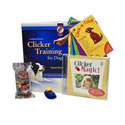
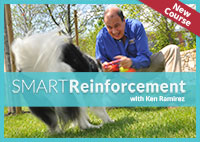
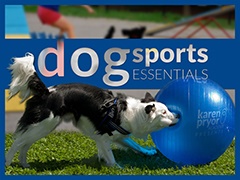
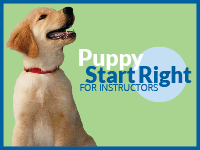



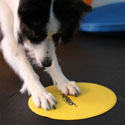
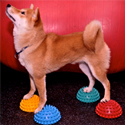
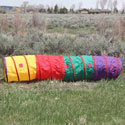

All Animals
Hi Everyone! I have just discovered this site, I am in england and have been clicker training my horse for a few weeks now, and thought I would tranfer it to my rather nervous 'scaredy Dog' black lab who has a fear of the kitchen, and anything that moves whilst near him. In our first session tnight of only five minutes, I had him eagerly using a spoon as a target, still nervous, but happy to trust me, which - with treats alone - we had not yet been able to do! Its such a wonderful method! I would love to hear of any games you uys play with the clicker to vary it up a bit for whne my scaredy dog really gets the hang of it! Then its on to my aggressive african grey - its me thats nervous then!!
regards,
laura
101 box game
Hi Laura,
Have you tried the 101 Things You Can Do With a Box game? It worked wonders for my Papillon, Little Freddi. She (yes, Freddi is a little girl) was really timid about appoaching the box at first, but the second day I tried it she actually was putting both front paws into the box! Now, her confidence is growing each time I use the box. Plus, I can almost see her thinking about what she can do to make me "click and treat!"
Good luck!
dena
New to clicker training
Many years ago I did a lot of obedience with my dogs, the old way it was. Now I am in a wheelchair and I have a rough Collie 17 months old, I am feeling really excited about clicker training as I believe this is going to bring me so much happiness as I can see with a clicker I can still train my wonderful collie and I don't have to move alot (just click) which is now very difficult for me to do.
And to have the close relationship with my Rough that i want so very much.
If anyone else out there is like me in a wheelchair and does clicker training with their dog please say hello
issie
Clicker training your rough collie (as an assistance dog?)
Hi Issie,
I'm thrilled you've discovered clicker training, and I'm discovering your post long
after you wrote it so I hope you get this! I wanted to encourage you to
seek out and watch the excellent DVD series "Clicker Train Your Own Assistance Dog"
by Barbara Handelman, M. Ed.
The dog on the cover is a magnificent blue merle rough collie. I think you'll love this
resource. Hope you and your dog are doing well.
Diane Bassett
www.dogtrainingwithdiane.com
diane at dogtrainingwithdiane.com
Target training
Was with my new puppy at training today and learnt about the target method. She has responded so well to the clicker that I am very encouraged and have ordered one of your target sticks. She is 6 months old and a german shepherd.
Really beautiful. I find your site very informative and will be visiting a lot more now. Have just been very busy.
Can i link my blog here to my other blog that i have for my writing.
I do freelance writing.
Regards,
Norms
Post new comment